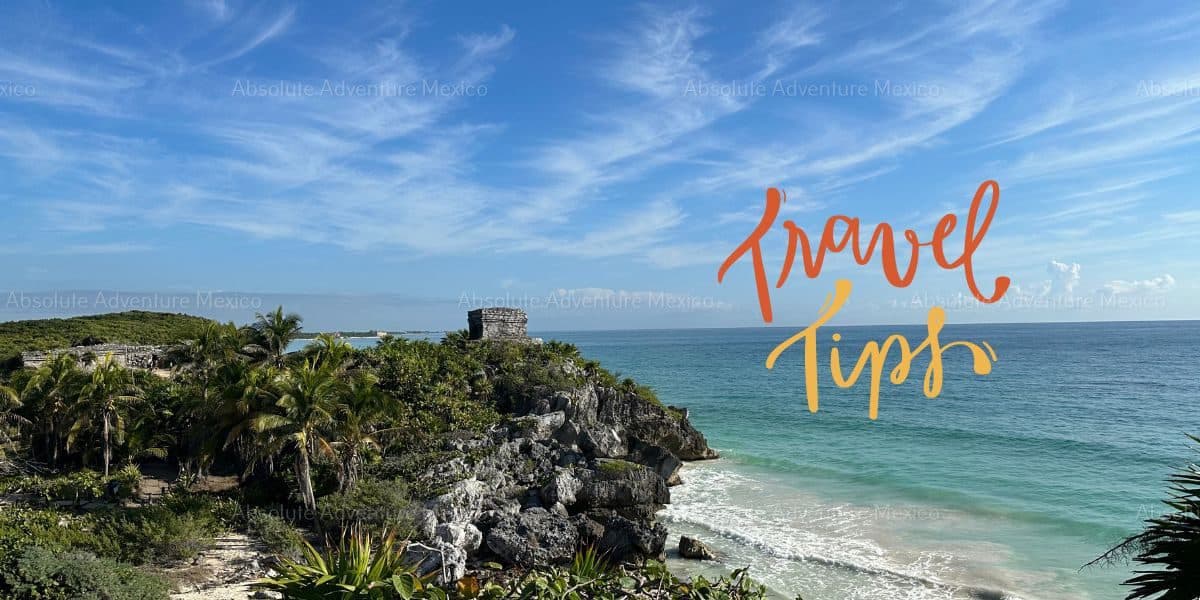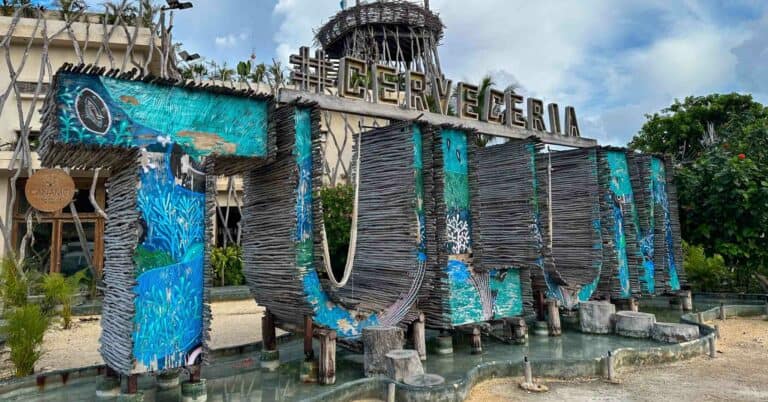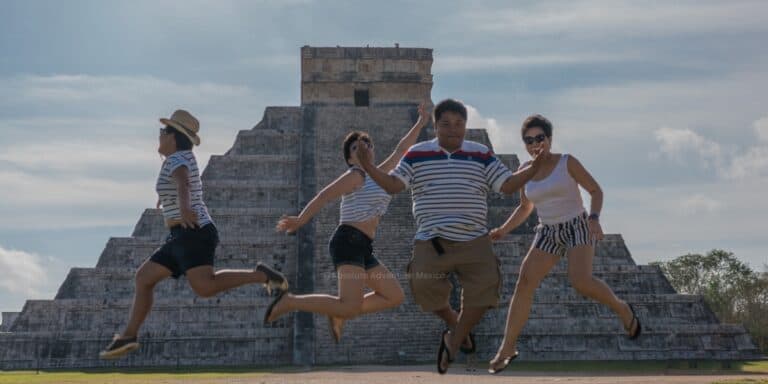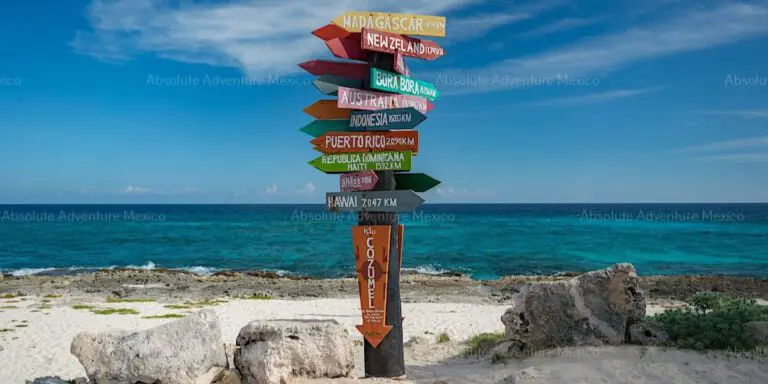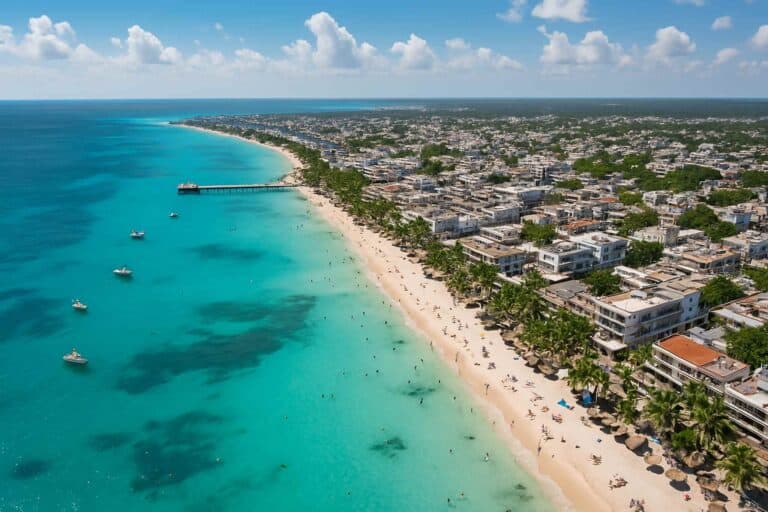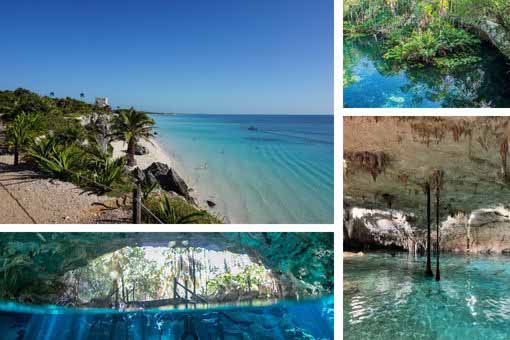Planning a trip to Mexico’s Caribbean coastline?
The Riviera Maya is one of the most stunning regions in the world, offering a perfect mix of turquoise beaches, ancient Mayan ruins, cenotes, and vibrant culture.
Whether you’re visiting for a few days or a couple of weeks, these Riviera Maya travel tips will help you make the most of your adventure.
Essential Riviera Maya Travel Tips: What to Know Before You Go
Best Time to Visit the Riviera Maya
The Riviera Maya is a year-round destination, but the best time to visit depends on what kind of trip you want.
Dry season (November to April): Ideal weather, low humidity, and plenty of sun. This is also high season, so expect larger crowds and higher prices.
Wet season (May to October): Fewer tourists and greener landscapes. There’s more rain, especially in the afternoon, and higher humidity.
Even if you’re visiting during the rainy season, it doesn’t mean it will rain all day, every day — showers are often short and scattered. Plus, there are plenty of fun things to do when it rains! Check out our article on rainy day activities in the Riviera Maya.
Hurricane season: June to November, with September and October being the riskiest months. Always check the weather forecast and travel insurance options.
Travel Documents & Entry Requirements
Most travelers from the US, Canada, UK, and the EU can enter Mexico without a visa for tourism purposes (up to 180 days). However, here’s what you’ll need:
- A valid passport: Unlike some countries that require a passport to be valid for at least 6 months beyond your arrival, Mexico does not have a six-month validity rule for travelers from the U.S., Canada, UK, EU, and most other countries. However, It’s strongly recommended to have at least 6 months of validity remaining on your passport when traveling internationally. Airlines or transit countries might have their own rules and could deny boarding if your passport is too close to expiring.
- A completed Multiple Immigration Form (FMM) — often handed out on the plane or done online
- Address of your first stay (hotel or Airbnb)
Tip: Keep your FMM form with your passport, as you’ll need it when exiting the country.
Currency, ATMs & Tipping in Mexico
The official currency in Mexico is the Mexican peso (MXN). While some businesses accept USD, the exchange rate is rarely favorable. It’s best to pay in pesos whenever possible.
ATMs are widely available, but avoid those in touristy areas (like bars or souvenir shops) for safety and better rates. Use ATMs inside banks when possible.
Credit cards are accepted in hotels and large restaurants, but smaller shops may only take cash.
Tipping is customary: 10–15% in restaurants, 20–50 MXN for bellhops, and tips for guides or drivers are appreciated.
Transportation: How to Get Around the Riviera Maya
Navigating the Riviera Maya is relatively easy, and you’ve got several options:
Private Transfers: Best for airport pickups and longer day tours. Reliable and comfortable.
Rental Cars: Great for flexible travel, but be aware of insurance scams and watch for speed bumps (“topes”).
Taxis: Readily available but often unmetered. Always agree on the fare in advance.
Colectivos: Shared minivans used by locals — cheap and convenient for short trips between towns.
ADO Buses: Affordable, air-conditioned intercity buses between Cancun, Playa del Carmen, Tulum, and more.
Mayan Train (Tren Maya): The new Tren Maya is now operating in the region, but with limited departures per day. It tends to be more expensive, and the stations are not centrally located, often requiring a taxi or transfer to reach. Current schedules are not ideal for day trips, so the train is better suited for longer journeys between major cities rather than short local travel.
What to Pack for Your Riviera Maya Trip
Clothing
- Lightweight, breathable clothing (linen, cotton, quick-dry fabrics)
- Swimsuits (at least two)
- Quick-dry towel or travel towel
- UV-protection shirt (rash guard) for snorkeling or kayaking
- Lightweight party clothing for beach clubs, bars, or hotel nightlife
- Tennis shoes or sturdy sneakers for ruins, jungle hikes, ATV tours, or adventure parks
- Water shoes for cenotes, rocky beaches, or slippery paths
- Light jacket or sweater for cooler evenings (especially in winter)
Toiletries & Personal Care
- Sunscreen (biodegradable only)
- Insect repellent
- Basic first aid kit (band-aids, antiseptic, any personal medications)
- After-sun aloe gel or moisturizer
- Personal hygiene items (toothbrush, razor, etc.)
Gear & Accessories
- Snorkeling gear (mask and snorkel) if you plan to snorkel often — more hygienic and cost-effective
- Camera or underwater camera to capture cenote and reef adventures
- Waterproof phone pouch or dry bag
- Sunglasses and sun hat
- Reusable water bottle (many eco-conscious spots offer refill stations)
- Daypack or small backpack for excursions
Documents & Travel Essentials
- Valid passport (ideally with at least 6 months before expiration)
- Copies (digital) of passport, travel insurance, and reservations
- Travel insurance covering health and activities
- Credit/debit card and some pesos in cash (especially for tips or small vendors)
- Driver’s license (if renting a car or driving ATVs)
Mosquitoes & Dengue Protection
Mosquitoes are common in the Riviera Maya, especially during the rainy season and near jungle areas, cenotes, or mangroves. While not a major risk, dengue fever has been reported in the region. Here’s how to stay protected:
- Use insect repellent with DEET or picaridin (apply after sunscreen).
- Wear long sleeves and pants in the evening or when hiking.
- Choose accommodations with screens, air conditioning, or mosquito nets.
- Avoid leaving stagnant water (in bottles or containers) near your lodging.
Tip: Citronella-based natural repellents can work for short periods, but they’re not as effective in humid jungle areas.
Electricity & Power Outlets - Internet, SIM Cards & Connectivity
ELECTRICITY:
Mexico uses Type A and Type B plugs, which are the same as those used in the United States and Canada. The standard voltage is 127 V with a frequency of 60 Hz.
Travelers from the US and Canada don’t need a power adapter or converter.
Visitors from Europe, Asia, or South America will likely need a plug adapter and possibly a voltage converter for certain electronics (especially hair dryers or curling irons).
Most hotels and accommodations offer several outlets, but it’s still handy to pack a multi-port USB charger for your devices.
INTERNET:
Most hotels and cafes offer Wi-Fi, but it can be slow in some areas.
SIM Cards: Telcel and AT&T offer prepaid SIMs with data for tourists. You’ll need an unlocked phone.
Roaming: International plans from your home carrier may be expensive, so check rates beforehand.
Tip: Download offline maps (Google Maps or Maps.me) before heading to remote sites or cenotes.
Safety Tips for Tourists
Riviera Maya is generally safe for travelers, but keep these tips in mind:
- Use registered taxis or trusted transportation services.
- Avoid flashing cash or expensive jewelry.
- Don’t leave belongings unattended on the beach.
- Use sunscreen and stay hydrated — heatstroke and sunburn are common!
- During hurricane season, stay informed and flexible with plans.
Food, Water & Staying Healthy
Mexican cuisine is a highlight of any trip, but here’s how to stay safe and healthy:
- Drink only bottled or purified water. Avoid tap water, even for brushing teeth.
- Enjoy street food from vendors that appear busy and clean.
- Try local favorites like tacos al pastor, ceviche, and cochinita pibil!
- If you have a sensitive stomach, consider taking probiotics before your trip.
Environmental & Cultural Respect
The Riviera Maya is home to fragile ecosystems and rich cultural heritage. Responsible tourism makes a difference:
- Use reef-safe sunscreen to protect marine life in cenotes and coral reefs.
- Don’t touch or step on coral while snorkeling.
- Respect Mayan communities and archaeological sites.
- Don’t leave trash behind, even in remote areas.
Booking Tours & Activities
There’s no shortage of incredible experiences in the Riviera Maya — from Mayan ruins to cenotes, snorkeling, and jungle adventures. To make the most of your trip:
Book in advance to secure your spot and get the best rates, especially during high season.
Choose trusted operators — we recommend booking through official local tour agencies. While hotels can arrange tours, they often include a commission, which may raise the price.
Do your research by checking reviews, reading detailed descriptions, and comparing what’s included.
Decide between group or private tours based on your budget and the kind of experience you’re looking for. Private tours offer more flexibility, comfort, and personalized service.
FAQ: Riviera Maya Travel Tips
Is the Riviera Maya safe for tourists?
Yes, the Riviera Maya is generally considered a safe destination, especially in tourist zones like Playa del Carmen, Tulum, and the hotel zone in Cancun. As with any destination, use common sense: avoid isolated areas at night, don’t flash valuables, and stick with trusted transportation providers.
When is the best time to visit?
The dry season (November to April) is the most popular time to visit thanks to sunny skies and warm temperatures. May to October is the rainy season, but don’t be discouraged — it usually means brief showers, not all-day rain. Plus, it’s a quieter and more affordable time to travel.
Do I need a visa or special travel documents?
Most travelers, including those from the U.S., Canada, the EU, and the UK, can enter Mexico visa-free for up to 180 days. You’ll need a valid passport with at least 6 months remaining before expiration, and you may be asked to show your return flight or hotel reservation upon arrival.
Can I use U.S. dollars or should I bring pesos?
Mexican pesos are the official currency and the best option for small purchases, local restaurants, or tips. While many businesses accept U.S. dollars in tourist areas, the exchange rate may not be favorable. ATMs are widely available if you need to withdraw pesos.
How do I get from the airport to my hotel or resort?
Cancun International Airport is the main hub for the Riviera Maya. You can pre-book a private transfer, take an airport taxi, or use the ADO bus if you’re traveling on a budget. For comfort and peace of mind, a pre-arranged shuttle is highly recommended.
Should I book tours in advance or wait until I arrive?
Booking in advance is the best way to ensure availability and competitive pricing. It also allows time to compare experiences, read reviews, and choose reputable providers.
Hotel desks can arrange tours last-minute, but prices may be higher due to commission.
What are the must-see attractions in the Riviera Maya?
Top spots include the ancient ruins of Tulum, Cobá, and Chichén Itzá; stunning cenotes like Dos Ojos and Taak Bi Ha; and snorkeling hotspots like Akumal or Cozumel.
What should I pack?
Pack light, breathable clothing, swimwear, reef-safe sunscreen, insect repellent, and sturdy shoes for exploring ruins or adventure parks. Add a reusable water bottle, underwater camera, and your own snorkeling gear if you plan to be in the water often. See our full packing guide for details.
Is tap water safe to drink?
No, it’s not recommended to drink tap water in the Riviera Maya. Stick to bottled or purified water, which is widely available and often provided in hotels and restaurants. Use bottled water to brush your teeth if you have a sensitive stomach.
Is it easy to get by if I don’t speak Spanish?
Yes! English is widely spoken in hotels, restaurants, and tour agencies throughout the Riviera Maya. However, learning a few basic Spanish phrases can go a long way and is appreciated by locals.
Is the Maya Train a good option for getting around?
The new Tren Maya (Maya Train) has launched with limited daily routes and relatively high ticket prices. Currently, it’s not ideal for day trips due to its schedule and the need to take a taxi to/from the station. It’s better suited for long-distance travel between major regions in the Yucatán Peninsula.
For day trips, booking a private tour is a more flexible, time-efficient, and comfortable option.
Is seaweed a problem in the Riviera Maya?
At certain times of the year, especially between April and October, some beaches in the Riviera Maya may experience sargassum seaweed. The amount can vary daily and by location, and while many resorts and local crews work hard to clean it up, it may affect beach conditions.
For up-to-date information, tips on how to avoid it, and the best beaches with little to no seaweed, read our full article on seaweed in the Riviera Maya.

